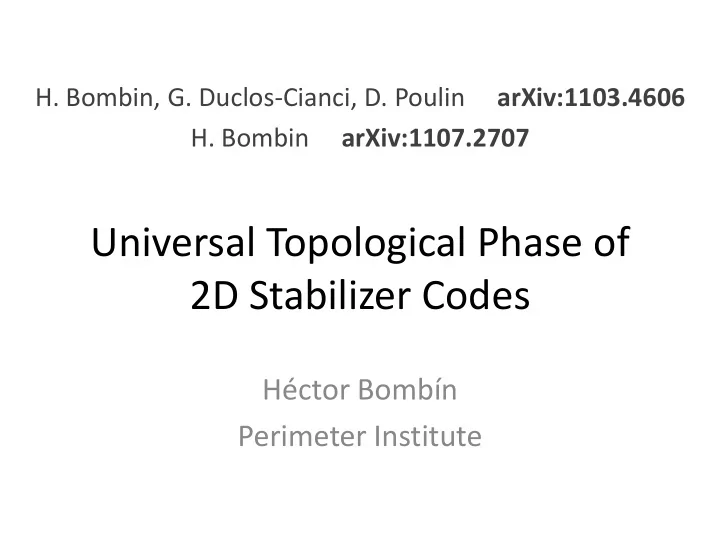

H. Bombin, G. Duclos-Cianci, D. Poulin arXiv:1103.4606 H. Bombin arXiv:1107.2707 Universal Topological Phase of 2D Stabilizer Codes Héctor Bombín Perimeter Institute
collaborators David Poulin Université de Sherbrooke Guillaume Duclos-Cianci
topological codes general structure?
translational invariance classify the bulk!
topological order • gapped excitations • GS degeneracy • locally indistinguishable GS
topological order • gapped excitations topological order describes the equivalent • GS degeneracy classes defined by local unitary evolutions • locally indistinguishable GS (Chen, Gu, Wen ’10)
topological order • they argue that two gapped GSs… …are in the same phase …can be connected adiabatically without closing the gap …are connected by a local unitary transformation …are connected by a quantum circuit of constant depth
topological order classify topological codes/order = classify long-range entanglement patterns
goals structure of 2D topological stabilizer (subsystem) codes equivalence up to local transformations
outline • anyons & toric code • universality • subsystem codes • conclusions
anyons in 2D systems
abelian anyons
toric code
strings & charges
mutual statistics • semionic interactions:
self-statistics • e, m are bosons, their composite is fermionic:
anyon model
outline • anyons & toric code • universality • subsystem codes • conclusions
topological stabilizer groups • local and translationally invariant (LTI) generators
topological stabilizer groups • local and translationally invariant (LTI) generators local undetectable errors do not affect encoded states
topological stabilizer groups
topological stabilizer groups
local equivalence coarse add/remove LTI graining disentangled Clifford qubits mapping
universality result • same anyon model ↔ equivalent! • ruling out chiral anyons (Kitaev ‘06): every 2D TSG is locally equivalent to a finite number of copies of the toric code
proof outline 1. 2D TSGs admit LTI independent generators 2. # charges < ∞ 3. anyon model from string operators 4. string segment framework , plaquette stabilizers 5. other stabilizers have no charge 6. map: string segments <--> string segments, uncharged stabilizers <--> single qubit stabilizers
string operators • coarse grain: • till each site holds any charge • till excitation pairs of same charge can be removed with string-like operators
anyon model
anyon model • well defined:
anyon model • well defined:
anyon model • charge generators: k k 1 1 2 2 b b b b b/f b/f i j i j i j
anyon model • charge generators: k k 1 1 2 2 b b b b b/f b/f toric code chiral case
string framework 2 1 1 2 • model independent commutation relations
mapping
outline • anyons & toric code • universality • subsystem codes • conclusions
subsystem codes
subsystem codes stabilizer group gauge group
topological subsystem codes
topological subsystem codes local undetectable errors do not affect encoded states
topological subsystem codes
topological subsystem codes
topological subsystem codes
generalized charge • Stabilizer charge morphisms = commutators
generalized charge • Gauge charge morphisms = commutators
topological ‘interactions’
charge morphism
canonical generators • gauge charge generators: non-interacting k k l 1 1 1 2 b b b/f b/f b b b/f • dual stabilizer charge generators: k k l 1 1 1 2
canonical generators • all possible anyon models are combinations of b b toric code: topological subsystem color codes: f f b subsystem toric code: f honeycomb subsystem code:
string framework
string framework • gauge generators (non-trivial charge) • stabilizer generators (non-trivial charge)
string framework every 2D TSC has a structure based on an anyon model
conclusions & questions • the long-range entanglement pattern of toric codes is universal for 2D topological stabilizer models • all 2D TSCs are anyon based • the same approach could be used for boundaries or point defects… • more general 2D models? • what about 3D?
Recommend
More recommend